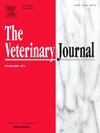Genomic prediction accuracy in Korean Holstein population: A comprehensive study of milk production traits
IF 3.1
2区 农林科学
Q1 VETERINARY SCIENCES
引用次数: 0
Abstract
This study evaluated methods to improve genomic prediction in Korean Holstein cows by comparing pedigree-based BLUP (PBLUP), genome-based BLUP (GBLUP), and single-step genomic BLUP (ssGBLUP). Phenotypic data were obtained from 14,377 Korean Holstein cows, provided by the National Agricultural Cooperative Federation and Korean Livestock Improvement Association. These records included first and second lactation data for 305-day total milk yield (Milk305), milk fat yield (Fat305), and milk protein yield (Prot305). Genotypic data for 2016 cows were obtained using the Illumina Bovine 50 K SNP BeadChip. Heritability estimates for Milk305, Fat305, and Prot305 were consistently the highest when using PBLUP for both lactations, whereas GBLUP yielded lower estimates and ssGBLUP provided intermediate values. The average accuracies for Milk305 were 0.424, 0.411, and 0.528 for PBLUP, GBLUP, and ssGBLUP, respectively, during the first lactation and 0.385, 0.375, and 0.486 for the second lactation. For Fat305, the accuracies were 0.403, 0.457, and 0.529 for the first lactation and 0.381, 0.304, and 0.487 for the second lactation. For Prot305, the accuracies were 0.409, 0.374, and 0.523 for the first lactation period, and 0.388, 0.371, and 0.496 for the second lactation period. The results show that ssGBLUP consistently outperforms traditional PBLUP and GBLUP in prediction accuracy. This study highlights the potential of advanced breeding techniques and strategic genomic integration to improve the efficiency and sustainability of dairy production in South Korea and beyond.
韩国荷斯坦奶牛种群的基因组预测准确性:产奶量性状的综合研究。
本研究通过比较基于系谱的BLUP (PBLUP)、基于基因组的BLUP (GBLUP)和单步基因组BLUP (ssGBLUP)来评估改善韩国荷斯坦奶牛基因组预测的方法。表型数据来自14,377头韩国荷斯坦奶牛,由全国农业合作联盟和韩国牲畜改良协会提供。这些记录包括305天总产奶量(Milk305)、乳脂产量(Fat305)和乳蛋白产量(Prot305)的第一次和第二次泌乳数据。使用Illumina Bovine 50K SNP BeadChip获得了2016头奶牛的基因型数据。当对两种哺乳期使用PBLUP时,对Milk305、Fat305和Prot305的遗传力估计始终是最高的,而GBLUP产生较低的估计,ssGBLUP提供中间值。Milk305对PBLUP、GBLUP和ssGBLUP在第一次泌乳时的平均准确率分别为0.424、0.411和0.528,第二次泌乳时的平均准确率分别为0.385、0.375和0.486。对于Fat305,第一次泌乳的准确率分别为0.403、0.457和0.529,第二次泌乳的准确率分别为0.381、0.304和0.487。对于Prot305,第一哺乳期的准确率分别为0.409、0.374和0.523,第二哺乳期的准确率分别为0.388、0.371和0.496。结果表明,ssGBLUP在预测精度上始终优于传统的PBLUP和GBLUP。这项研究强调了先进育种技术和战略性基因组整合在提高韩国及其他地区乳制品生产效率和可持续性方面的潜力。
本文章由计算机程序翻译,如有差异,请以英文原文为准。
求助全文
约1分钟内获得全文
求助全文
来源期刊

Veterinary journal
农林科学-兽医学
CiteScore
4.10
自引率
4.50%
发文量
79
审稿时长
40 days
期刊介绍:
The Veterinary Journal (established 1875) publishes worldwide contributions on all aspects of veterinary science and its related subjects. It provides regular book reviews and a short communications section. The journal regularly commissions topical reviews and commentaries on features of major importance. Research areas include infectious diseases, applied biochemistry, parasitology, endocrinology, microbiology, immunology, pathology, pharmacology, physiology, molecular biology, immunogenetics, surgery, ophthalmology, dermatology and oncology.
 求助内容:
求助内容: 应助结果提醒方式:
应助结果提醒方式:


